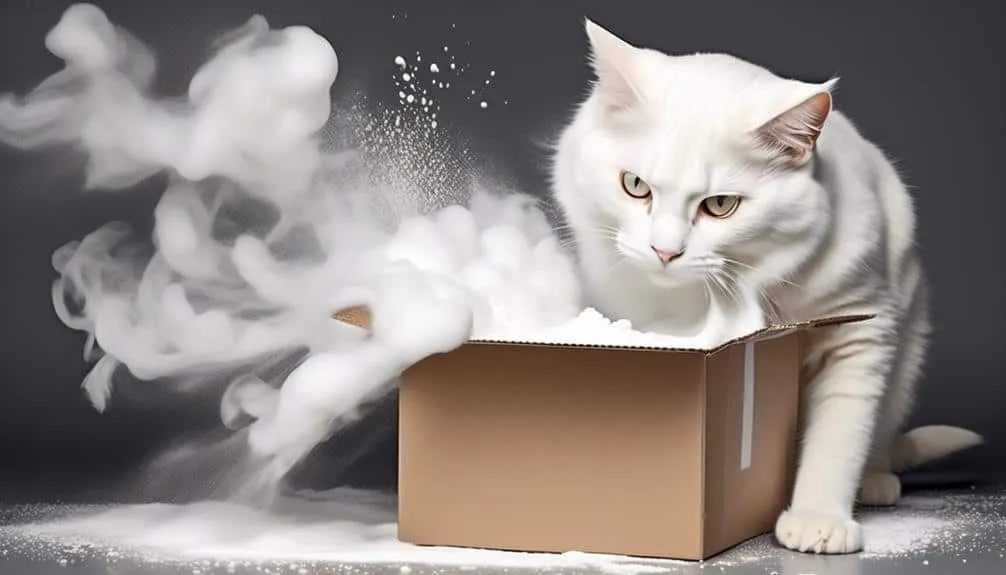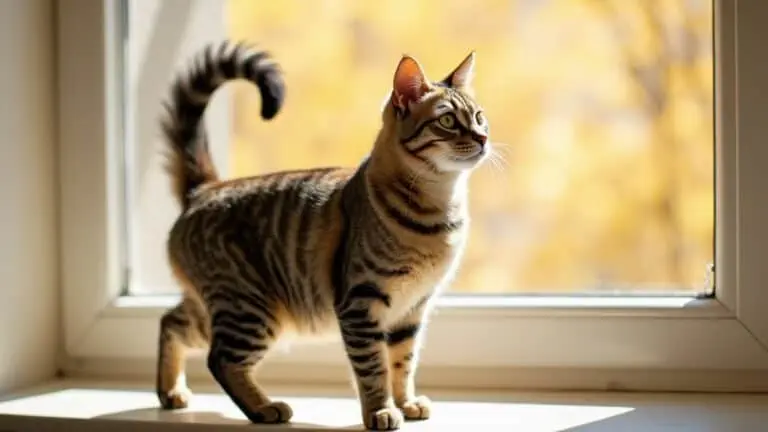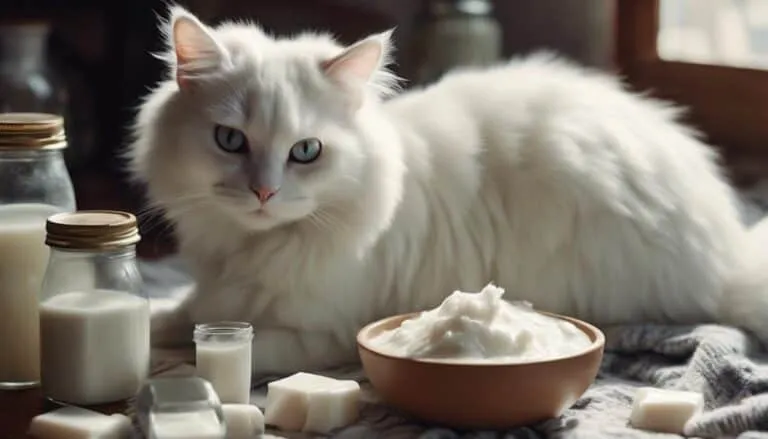The Best Fluffy Pancakes recipe you will fall in love with. Full of tips and tricks to help you make the best pancakes.

Baking soda, a seemingly innocuous household staple, has gained popularity for its versatility and numerous applications. However, what many cat owners may not realize is that this seemingly harmless ingredient can pose hidden dangers to their feline companions. In this article, we will explore the potential risks associated with baking soda and its impact on cats' health and well-being.
From the dangers of ingestion to its use in cat litter boxes and flea treatments, we will delve into the various aspects that pet owners should be aware of. But what exactly makes baking soda a hidden danger for cats? Let's uncover the truth behind this seemingly harmless substance and learn how to keep our furry friends safe.
Key Takeaways
- Baking soda contains high levels of sodium, which can cause electrolyte imbalances and toxicity in cats.
- Ingesting too much baking soda can lead to a range of negative symptoms and health issues for cats.
- It is important to monitor and prevent cats from ingesting baking soda, as even small amounts can be harmful.
- Baking soda may have limited effectiveness in reducing litter box odor and as a flea treatment for cats, and safer alternatives should be considered.
Dangers of Baking Soda for Cats
Baking soda poses potential dangers for cats due to its high sodium content and the risk of toxicity associated with its ingestion. Cats are more susceptible to baking soda toxicity than dogs due to their smaller size. Ingesting 1-2 teaspoons of baking soda can have negative side effects for cats, including stomach upset, gas, vomiting, diarrhea, excessive thirst, dehydration, weakness, muscle spasms, rapid breathing, convulsions, kidney damage, and coma.
It is important to monitor the amount of baking soda ingested by cats, as too much can lead to these symptoms. Cats may accidentally ingest baking soda while grooming themselves or cleaning their paws. If any of these symptoms occur, immediate veterinary attention is necessary to prevent further health risks.
Monitoring Baking Soda Consumption in Cats
Cats owners should be vigilant in monitoring the amount of baking soda their feline companions may inadvertently consume, as excessive ingestion of baking soda can lead to detrimental health effects. To ensure the well-being of cats and prevent accidental ingestion of baking soda, the following measures should be taken:
- Store baking soda securely: Keep baking soda containers out of reach of cats to prevent them from knocking them over or accessing the contents.
- Avoid using baking soda in cat litter: Although baking soda can help reduce litter box odor, it is best to avoid using it as it can potentially be ingested by cats during grooming.
- Monitor cleaning products: Be cautious when using cleaning products that contain baking soda around cats, as they may come into contact with it and accidentally ingest it.
Use of Baking Soda in Cat's Litter Box
The addition of baking soda to a cat's litter box can be a potential solution for odor control. Baking soda has been widely used for its ability to absorb and neutralize odors. When sprinkled at the bottom of the litter box, it can help minimize unpleasant smells. However, there are certain considerations to keep in mind.
It is important to note that baking soda can make the litter more dusty, which may be problematic for some cats. To minimize dust, it is recommended to sprinkle only 1-2 teaspoons of baking soda at the bottom of the litter box.
Additionally, it's worth mentioning that baking soda may not effectively neutralize ammonia gas, which is a major component of cat urine odor. Therefore, litters with baking soda already included or those containing charcoal may be more effective options for odor control.
Proper storage of baking soda is important to ensure cat safety. It should be kept in a cool, dry place, away from the reach of cats to prevent accidental ingestion.
Using Baking Soda for Flea Treatment in Cats
Flea treatment in cats can involve the use of baking soda in a supplementary manner for its potential dehydrating effects on fleas, eggs, and larvae. While applying baking soda directly on cat fur is not recommended, it can be used to treat carpets and furniture where fleas may be present.
Here are some important points to consider:
- Slow-acting technique: Baking soda needs time to dehydrate fleas, eggs, and larvae, so multiple applications may be necessary.
- Other flea treatment options: There are specifically designed flea treatments available for cats that are more effective and safer than using baking soda.
- Consult with a veterinarian: It is always best to seek professional advice for the most suitable flea treatment approach for your cat.
Safe Uses of Baking Soda for Cats
After discussing the potential use of baking soda for flea treatment in cats, it is important to explore the safe uses of baking soda for various purposes in and around the home.
While large amounts of baking soda can be toxic for cats, it can be safely used for certain purposes. When it comes to cat grooming, baking soda can be beneficial. It can be used as a dry shampoo to help absorb excess oil and odors from the cat's fur. Simply sprinkle a small amount of baking soda onto the cat's coat and brush it through gently.
Additionally, baking soda can be safely introduced to a cat's diet in small amounts as a dietary supplement. However, it is essential to consult with a veterinarian before doing so, as the appropriate dosage and frequency may vary depending on the cat's specific needs.
Frequently Asked Questions
Can Baking Soda Be Used as a Safe and Effective Flea Treatment for Cats?
Baking soda is not recommended as a safe and effective flea treatment for cats. It is more suitable for treating carpets or furniture, and other flea treatment options specifically designed for cats are recommended. Consult with a veterinarian for the best approach.
Are There Any Alternatives to Baking Soda for Reducing Odor in a Cat's Litter Box?
There are alternatives to baking soda for reducing odor in a cat's litter box. Natural odor control products, such as activated charcoal or litters with built-in deodorizers, may be more effective in neutralizing cat urine smells.
How Can I Prevent My Cat From Accidentally Ingesting Baking Soda?
To prevent accidental ingestion of baking soda by cats and mitigate potential hazards, it is crucial to monitor their access to the substance. Implementing measures such as securely storing baking soda and preventing cats from accessing areas where it is present can help minimize the risk.
What Should I Do if My Cat Accidentally Ingests a Large Amount of Baking Soda?
If your cat accidentally ingests a large amount of baking soda, it is crucial to seek immediate veterinary attention. Symptoms of baking soda poisoning may include stomach upset, vomiting, diarrhea, muscle spasms, and kidney damage.
Can Baking Soda Be Used to Clean My Cat's Toys or Bedding?
Yes, baking soda can be used to clean cat toys and bedding. However, there are natural alternatives to baking soda, such as vinegar or lemon juice, which are safer for cats and equally effective in removing odors and stains.
Conclusion
In conclusion, it is crucial for cat owners to be aware of the potential dangers associated with the use of baking soda. While it may have benefits in certain situations, such as controlling odors in litter boxes, caution must be exercised to prevent ingestion and potential health risks.
Alternatives should be considered for flea treatment, as baking soda may not be the safest option.
By understanding these hidden dangers and making informed choices, pet owners can ensure the well-being and safety of their beloved feline companions. As the saying goes, 'knowledge is power,' and in this case, it is essential for the health of our cats.








